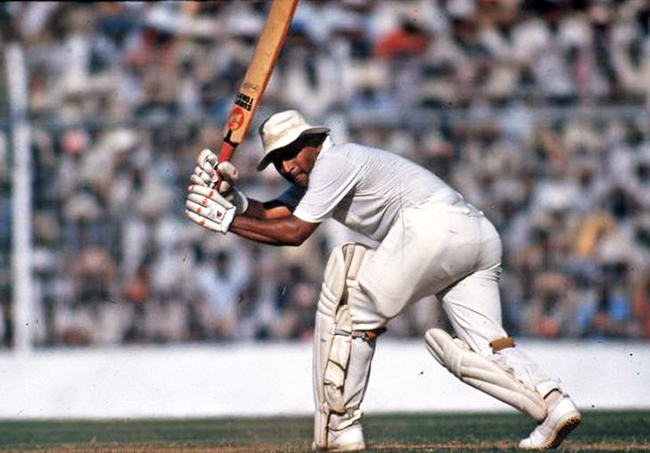Registered with the Registrar of Newspapers for India under R.N.I 53640/91
Vol. XXXIII No. 18, January 1-15, 2024
When Gavaskar surpassed Bradman’s long-standing record
-- by Partab Ramchand
For 35 years it had remained Test cricket’s most famous record. Don Bradman made the last of his 29 Test hundreds (in only 52 matches) in July 1948. Since then even with the proliferation of Test matches no one had close to surpassing it, the nearest being 26 notched up by Gary Sobers in 93 Tests. Finally on December 28 1983 at the MA Chidambaram stadium in Madras it was time to say “move over Don, it’s Sunny now.”
With his technical expertise and insatiable hunger for runs and big scores Sunil Gavaskar always looked in with a chance to get past Bradman’s tally. At the start of 1983 he had notched up 25 hundreds but with many Test matches to be played that year could he finally surpass the great man’s long-standing record was the question uppermost in the minds of Indian cricket fans.

Gavaskar got his 26th century in Pakistan in January and notched up No 27 in the West Indies in March. In the return series at home against Pakistan he hit his 28th century at Bangalore and by now as only to be expected there was tremendous excitement. Could he surpass or at least draw level with Bradman in the six-Test return series against West Indies?
In the first Test at Kanpur he was out for 0 and 7 and the manner of his dismissals suggested that at 34 the old reflexes were not there and it would be difficult to get a hundred against the likes of Malcolm Marshall, Michael Holding and Andy Roberts. But he promptly bounced back with an electrifying 121 in the next Test at New Delhi and this drew him alongside Bradman on 29. Now when and where would he go past Bradman was the question. He did come close to it in the next Test at Ahmedabad when he got to 90 before he was out. In the process he became the leading run getter in Tests going past Geoff Boycott’s record tally of 8,114 runs.
Gavaskar failed at both Bombay and Calcutta and so there was one last chance when the teams came to Chepauk for the final Test. With the opening day being washed out because of rain the Test was reduced to four days. West Indies after winning the toss scored 313. Gavaskar, drained out after opening the innings almost continuously since his debut in 1971 opted to come down the order. But Marshall dismissed Anshuman Gaekwad and Dilip Vengsarkar with successive deliveries without a run on the board. Gavaskar who had put on his gloves and pads and other protective gear in a hurry slowly wended his way to the crease to be met by Vivian Richards who told him “Man, it makes no difference coming lower down the order; the score is still zero.”
Slowly Gavaskar and Navjot Sidhu started a recovery before the latter was out for 20 at 54. Ashok Malhotra did not last long and at 67 for four India were shakily placed. Shivlal Yadav came in as night watchman and at stumps India were 69 for four with Gavaskar on 36.
Yadav left at 92 the following morning and Ravi Shastri joined Gavaskar. The Bombay duo settled down comfortably and made runs freely against the pace quartet of Holding, Marshall, Roberts and Winston Davis. Gavaskar brought up his half century and now the near capacity crowd were cheering every run fully aware that they could be witnessing history. And indeed history was created in mid afternoon when Gavaskar at 99 drove Davis to the onside for a single and the spectators rose to give him a standing ovation which was loud and long. At the tea interval as he came in he presented the precious bat to West Indies wicketkeeper Jeff Dujon fulfilling a promise he had made to him earlier in the series.
Gavaskar and Shastri continued in the same vein after the interval till the latter was out to the last ball of the day for 72 after the partnership had added 170 runs for the sixth wicket. Gavaskar was 149 at stumps and while the match was written off as a draw with India 262 for six, interest centered around Gavaskar on the final morning. How much more could he get and more important could he get to his double hundred. No batsman had got three double hundreds against West Indies and though Roger Binny and Kapil Dev left to make India 308 for eight, Gavaskar found an able partner in Syed Kirmani in whose company he did reach 200.
That landmark over and done with, Gavaskar now could look forward to another important record – Vinoo Mankad’s 231 as the highest by an Indian in Test cricket. That also had been notched up at Madras in January 1956 but at the corporation stadium. Even after over ten hours at the crease Gavaskar was concentration and determination personified and shortly after tea he went past Mankad’s score and remained unbeaten with 236 when Kapil declared the innings closed at 451 for eight with Kirmani on 63. In all Gavaskar batted 644 minutes, negotiated 425 balls and hit 23 fours. In his 99th Test and 174th innings Gavaskar finally stood on the pedestal one ahead of Bradman. Exactly 40 years have passed but for those lucky enough to be present at the MAC stadium the memories will linger on forever.

